Die Schwierigkeit des Zentaurs beim vom Pferd steigen
The Centaur’s Difficulty when Dismounting the Horse
La Difficulté du Centaure à descendre de cheval
Greek Pieces 5
CR 51. Year 1976

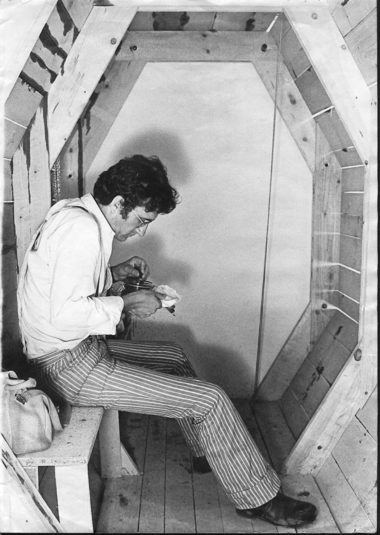
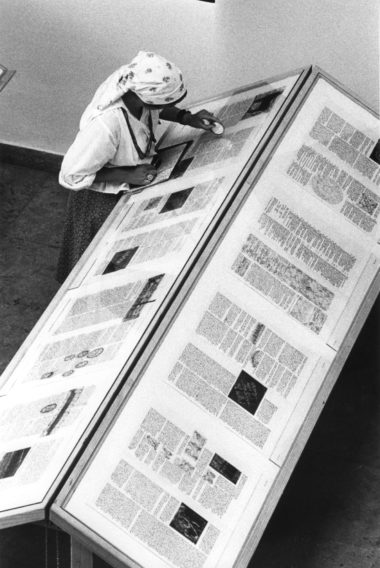

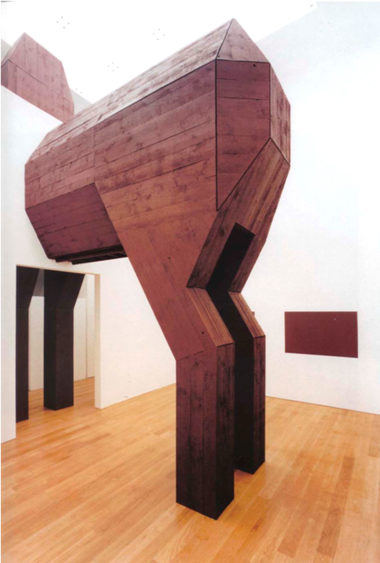

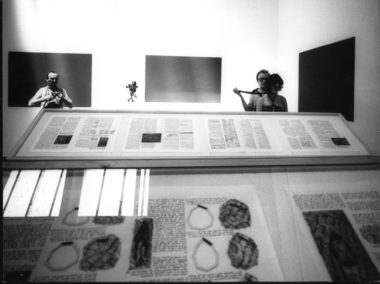
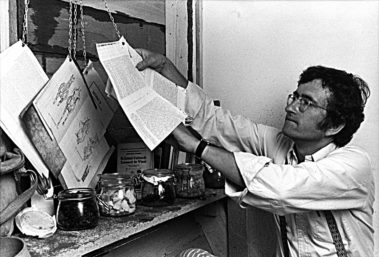


- DE
- EN
Das Pferd aus einem Achteck aufbauen. Überall die simpelste, bekannteste Lösung bevorzugen. Es soll ein Pferd sein, daß man selbst bauen kann. Es soll ganz anonym sein, man kann den Betrachtern vertrauen, ihrem Zwang zur Gestaltung, sie werden es schmücken (die visuelle Notdurft). [18]
The Centaur in difficulties to dismount, … is civilised man who finds it hard to rid himself of this civilisation.”
Karlheinz Nowald 1976
But what then matters to the author? To breathe, to remain flexible, trunk circling, as he repeatedly states with a sporty undertone: “To move without getting anywhere.” To be indifferent, to watch, not to take up a position, not to take part in the “organisation”, to be empty, to let it pass through oneself, to remain adaptable. “Not to serve the good cause. Not to free Jerusalem. To exhale.” That might sound Far Eastern, but in its provocative softness it is without fatal mysticism. More situationist instead, clinging to the moment as an atom of time.
Günther Metken 1978. Translated by e_CR editors
Was zählt aber dann für den Autor? Atmen, beweglich bleiben, Rumpfkreisen, wie er immer wieder mit sportlichem Unterton sagt: "Sich bewegen, ohne von der Stelle zu kommen." Indifferent sein, zuschauen, keinen Posten annehmen, bei der "Organisation" nicht mitmachen, leer sein, durch sich hindurchgehen lassen, weich - anpassungsfähig bleiben. "Der guten Sache nicht dienen. Jerusalem nicht befreien. Ausatmen." Das klingt fernöstlich, ist aber in seiner provokanten Sanftheit ohne fatale Mystik, eher situationsitisch, dem Augenblick als Atom der Zeit angeschmiegt.
Günther Metken, 1978
Gerz’s view of art as a weapon and of the somehow permanent performance of aggression in the pavilion building is made the ironic subject of his installation, The Centaur’s Difficulty When Dismounting the Horse. The Centaur, resembling in fact a hollow wooden horse, was installed in two adjacent rooms in the left wing of the building, with most of the abdomen and rear of the horse in one room, and the upper body in the other. The horse was a threatening but fragmentary object of perception, since there was no way to grasp the whole from one position… The allusions in this historically resonant performance are both concrete and threatening: German fascination with Greek art, anchored in nineteenth-century philhellenism, was the official aesthetic of National Socialism, driven by the Nazi belief in a mythic connection between the German and Greek “races.” Gerz may have been poking fun at the equestrian monstrosities of the two most prominent residents of the German pavilion under Hitler, Arno Breker and Josef Thorak… While seeming to idealise the Greeks, and celebrating the plot that ended the Trojan War, Gerz positioned the horse as a destructive, even self-destructive element inside the architecture. The Aeneid tells how the Trojans dismantled their own city wall to get the horse inside, suggesting that they were partly responsible for their fate. Is the Centaur an imaginative invitation to dismantle the pavilion, the real monument in question? Or a threat of architectonic Blitzkrieg from an official German artist? It is hard to decide. Gerz’s hostility to both pavilion and his role as public artist is summed up in the metaphor of the trap meant to destroy the city and its inhabitants. The ambiguity implicates the viewer in the functioning of the monument. In parsing Gerz’s Greek metaphors, we must take our places imaginatively as the authors or the victims of violence. The perspective of Gerz’s early work allows us to see the affinity of his and Beuys’ Venice projects. In both projects, performance destabilises the monument, which is at once reestablished at the intersection of action and history: Beuys by shaping the reception through photographs, interviews, and the change in display, Gerz by allusions that are threateningly vague, an indeterminacy of content achieved by the rumour of unknown actions performed inside the horse and the display of illegible diary entries and monochrome images that look like they had been painted over. Both artists combine history, myth, and biography in an attempt to engage spectators individually, in ways radically unlike the institutionalised performance of history in French Revolutionary and fascist mass rallies. Neither artist has at his disposal a new convention suited to individual commemoration.
Mechthild Widrich 2014
Categories
Keywords
Installation / Performance
Framing lumber sculpture (painted with photographic opaque), 810 x 588 x 160 cm, 24 manuscript sheets (photographic opaque and b/w photographs on blue chequered paper), each 50 x 65 cm, in three wooden tabletop showcases, 10 picture surfaces (photographic opaque), each 100 x 150 cm
The Centaur occupies two rooms. The separating wall divides the figure into a head and a body. The 24 manuscript sheets are in the adjacent room. Reading from right to left, the handwritten text reflects upon the obsolescence of civilization and the artist’s existence. Pictures are painted in photographic opaque on the wall. The first version was realized for the German Pavilion at the Venice Biennial in 1976. During the opening ceremonies, Jochen Gerz stayed inside the Centaur for several days. The second version was installed at the Museum Wiesbaden in 1997.
The manuscript (654) has been exhibited on several occasions. An edition of the manuscript was realized (787).
Museum Wiesbaden
Exhibitions of the manuscript
München 1976. Chur 1978. Graz 1978. Frankfurt 1980. Düsseldorf 1991
Documentation
b/w photographs of the Venice installation
Exhibitions of the documentation
München 1976. Luzern 1979. Bruxelles 1985
Bibliography
I: Lubin 1976. München 1976, pp. 13-168. Venezia 1976b, pp. 3-10, 69-106. Chur 1978, pp. 27-30. Hannover 1978, pp. 11-15. Ljubljana 1978, p. 201. Luzern 1979, pp. 90-91. Frankfurt 1980, pp. 15-16. Bielefeld 1981, p. 106. Valencia 1982, p. 73. Ludwigshafen 1984, pp. 10-11, 62-75, 80, 100. Bruxelles 1985, pp. 79-81. Bucarest 1985, p. 44. Saarbrücken 1985, p. 4. Bielefeld 1985, pp. 37-57. Düsseldorf 1991, pp. 219-223. Figeac 1991, pp. 108-109. Montréal 1993, pp. 19-20. Paris 1994a, pp. 98-120. Vancouver 1994, pp. 12-13. Regensburg 1995a, pp. 235-237. Wiesbaden 1997, pp. 11, 70- 83. Ivry-sur-Seine 2017, pp.217, 172-173
II: Red. 9, 1976, pp. 46-51. Bürklin 1976, p. 19. Curtze 1976, pp. 75-76. Dencker 1976, p. 6. Giroud 1976, p. 5. Henzen 1976. Mavrommatis 1976, p. 9. Nowald 1976. Raschke 1976, p. 855. Rein 1+2, 1976. Red. 1, 1976, p. 85. Red. 2, 1976, p. 19. Red. 3, 1976. Sello 1976, p. 40. Spiess 3, 1976. Schneider 1976. Dencker 1977, pp. 16-37. Kennedy 1977, pp. 36-38, 56. Staber 1977, p. 37. Hartmann 1, 1978, p. 5. Hartmann 2, 1978, pp. 3-4. Kipphoff 1978, p. 47. Kradolfer 1978, p. 29. Red. 15, 1979, pp. 102-106. Krämer-Badoni 1980. Javault 1983, p. 34. Besson 1, 1985, p. 15. Drateln 1989, p. 45. Drateln 1990, p. 63. Drateln 1991, p. 23. Pejic 1992, p. 78. Béraud 1994, p. 12. Fleck 1995, p. 78. Asmuth 1+2, 1997. Baer-Bogenschütz 1+2, 1997. Bonekämper 1997. Crüwell 1997. Dering 1997. Feeser 1997. Fischer 1+3, 1997. Gries 1997. Haase 2, 1997. Henke 1+2, 1997. Huther 1-4, 1997. Kuni 1997. Melten 2-4, 1997. Rudel 1+2, 1997. Schneebeli 1997. Schossig 1997. Schwarze 1997
III: Pohlen 1978, pp. 14-15. Rogendörfer 1990, p. 228
IV: Nuremberg 2018
V: Bulkowski 1977, p. 52. Heißenbüttel 1977, pp. 85-97. Metken 1977, pp. 133-135. Mahlow 1977, pp. 19-24. Skira 1977, pp. 92, 136-137. Almanach 1978, pp. 5.12. Krug-Mann 1979, p. 365. Molderings 1984, p. 168. Molderings 1985, p. 198. Thomas 1985, p. 217. Blümler 1989, pp. 3, 7-8, 10, 14. Wolf 1992, pp. 38ff., 192. Metken 1996, p. 173. Drathen 2004, p. 109. Widrich 2014, pp. 145-160. Gieser 2022, pp. 331-335
VI: Frankfurter Allgemeine Zeitung 1996, p. 31